東南アジア インド洋と太平洋の間にある多様な熱帯の国々のグループであり、両方の影響を受けた文化を特徴としています インド そして 中国 華僑の大規模なコミュニティをホストしています。この地域には、世界で最も人口の多いイスラム教国であるインドネシア、非常に著名な仏教国、そして非常に重要なキリスト教、ヒンズー教、アニミストのコミュニティが含まれています。東南アジアは、完璧なビーチ、おいしい料理、低価格、そして飛行機の乗り継ぎが良いことで知られる、世界を駆け巡るバックパッカーにとって長い間世界のお気に入りの一角でした。
国
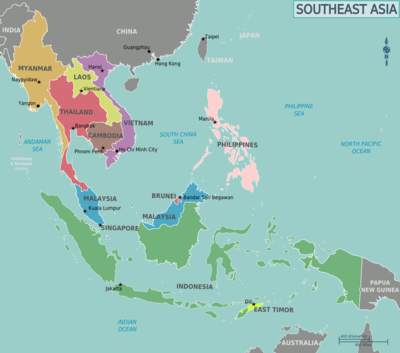
| ブルネイ 油分が豊富な小さなスルタン ボルネオ、ほとんど訪れませんが、マスツーリズムによってまだ商品化されていない静かなモスクと文化的な場所でいっぱいです |
| カンボジア の古代都市の故郷 アンコール かつて強力だったクメール帝国の他の遺跡は、何十年にもわたる戦争からまだ回復しています |
| 東ティモール 世界で最も新しい州の1つである、ティモール島の東半分にあるかつてのポルトガルの植民地は、この地域で優れたダイビングと独特の文化を誇っています。 |
| インドネシア 16,000を超える島々と世界最大のイスラム教徒が多数を占める国を擁する世界最大の群島国ですが、名目上は世俗的であり、ヒンドゥー教と仏教の文化に深く影響を受けています。 |
| ラオス この地域で唯一の内陸国であり、人口が最も少ない、主に仏教徒のラオスは、見事な自然の風景と魅力的なのんびりとした町を持っています |
| マレーシア イスラム教徒のマレー人、主に仏教徒の中国人、主にヒンズー教徒のインディアン、そして特にボルネオの多くのオランアスリ先住民を含む) クアラルンプール ジャングルに住む部族へ ボルネオ |
| ミャンマー (ビルマ) 驚異的な民族の多様性を備えた古代の国。その歴史には、先住民帝国と大英帝国の一部の両方が含まれています。 |
| フィリピン 非対立と長老への敬意というアジアの伝統とスペインのアイデアのユニークな融合 マッチョ、ロマンスと洗練(そして現代のアメリカニゼーション)、この地域で最大のキリスト教国家、そして7,641の島々を持つ2番目に大きな群島–ほとんどが美しい熱帯のビーチ、暖かさとフレンドリーな笑顔を持っています |
| シンガポール 繁栄し、清潔で整然とした島の都市国家であり、中国人が過半数を占めていますが、マレーとインドの強力なコミュニティがあり、この地域の主要なビジネスと金融の中心地です。 |
| タイ 熱狂的な都市、落ち着いたビーチ、仏教王国の遺跡など、豊かな文化と料理で知られる、この地域で唯一西洋植民地主義を回避した国であり、何度も訪れる訪問者に非常に人気のある目的地となっています |
| ベトナム 世界で最も急速に成長している経済の1つとして資本主義への道をしっかりと進んでいるベトナムは、東南アジアと中国の価値観と文化が融合しており、自然と文化の両方の魅力が非常に多様です。 |
この地域で争われている地域は次のとおりです。
- 西沙諸島 –中国が管理しているが、ベトナムも主張しており、外国人観光客は訪問できない
- 南沙諸島 –領土問題の目まぐるしい混乱にさらされている、ほとんど無人の島やサンゴ礁の束ですが、注目すべき唯一の目的地はダイビングリゾートです ラヤンラヤン.
東ティモールを除いて、上記の他の10か国は、東南アジア諸国連合であるASEANのメンバーです。
海南 (一部の 中国)および 台湾 東南アジアと同様の自然と文化遺産を持っています。
都市

東南アジアで最も有名な9つの都市は次のとおりです。
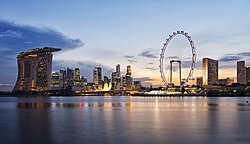
- 1 バンコク —ナイトライフと熱意に満ちたタイのにぎやかな国際的な首都
- 2 ホーチミン市 (旧サイゴン)—ベトナム最大の都市および主要な経済の中心地となったにぎやかな大都市
- 3 ジャカルタ —東南アジア最大の大都市、そして夕方の美しい生活
- 4 クアラルンプール —小さな眠そうな中国のスズ鉱山の村からにぎやかな大都市へと成長しました
- 5 ルアンパバーン — a ユネスコ世界遺産都市 数多くの寺院、植民地時代の建築、活気に満ちたナイトマーケットで知られています
- 6 マニラ —文化と味のユニークなブレンドで知られる混雑した歴史的でにぎやかな街で、見たり体験したりする場所がたくさんあります
- 7 プノンペン — 1970年以前に知られていた、「アジアの真珠」の名前を取り戻すために努力している都市
- 8 シンガポール —中国、インド、マレーの影響を受けたメドレーのあるモダンで裕福な都市
- 9 ヤンゴン (旧ラングーン)—パゴダと植民地時代の建築で知られるミャンマーの商業首都
その他の目的地

ここの主要都市の外に、最もやりがいのある目的地のいくつかがあります:
- 1 アンコール遺跡公園 —クメール王朝のいくつかの首都の壮大な遺跡
- 2 バリ —「神々の島」のユニークなヒンドゥー教の文化、ビーチ、山々
- 3 ボロブドゥール —世界最大の仏教寺院の1つ
- 4 グヌンムル国立公園 —幻想的な石灰岩の洞窟とカルスト地形
- 5 ハロン湾 —風光明媚な岩の形成で有名な、文字通り「降順のドラゴンの湾」と訳されています
- 6 コモド国立公園 —世界最大の爬虫類であるコモドの唯一の家
- 7 クラビ県 —ビーチとウォータースポーツのメッカ、 アオナン, ライレー, ピピ島 そして ランタ島
- 8 パラワン —フィリピンの西端にある、生態学的に多様で比較的目詰まりのない島で、世界で最もやりがいのあるダイビングや水泳の場所がいくつかあります。
- 9 プレアヴィヒア —アンコールワット以前の崖の上の寺院
理解する
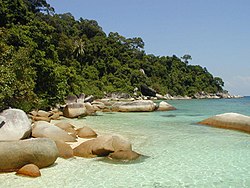
東南アジアは、世界で最も人気のある観光地の1つであり、その理由もあります。ここにある国のいくつかはそれをすべて持っています: 熱帯気候、一年中暖かい(または暑い!)、豊かな 文化、ゴージャス ビーチ、素晴らしい 食物 そして最後になりましたが、 低価格。その歴史と現代の政治は複雑ですが、そのほとんどは非常に安全で、移動も簡単です。
この地域は、 海外で引退、および地域のいくつかの政府が提供しています 特別長期ビザ 特に退職者のために。
歴史
先史時代の東南アジアは大部分が過疎でした。ベンガル湾を越えてインドから移民するプロセスは、 インド化。それがいつどのように起こったのかが正確に争われます。しかし、本土地域の人口は主にからの移民によって発生しました インド。現代のタイ語、ラオス語、ビルマ語、クメール語の基礎として今でも使用されているサンスクリット語のスクリプトは、このプロセスに端を発しています。一方、東ティモール、インドネシア、フィリピン、そして本土のマレーシアの群島の人口は、からの移民によってもたらされたと考えられています。 台湾 と南部 中国.
ヨーロッパ人が到着する前は、東南アジアにはいくつかの強力な王国がありました。より注目すべきもののいくつかは、インドシナ半島の扶南国とクメール王朝、そしてマレー諸島のスリビジャヤ、マジャパヒト王国、マラッカ王国でした。
東南アジアの歴史は非常に多様で、しばしば混乱しており、重要な範囲で ヨーロッパの植民地主義。まさに東南アジアという用語は、1940年頃にアメリカ海軍の戦略家によって発明されました。第二次世界大戦以前は、東南アジアは植民地の力の観点から言及されていました。 遠インド にとって ビルマ そして タイ、タイ自体が正式に植民地化されたことはありませんが、インドの主要な英国の植民地を参照してください。 インドシナ のフランス植民地に言及 カンボジア, ベトナム そして ラオス、ながら インドネシア そして海域東南アジアの一部は オランダ領東インド. マレーシア半島 そして シンガポール として知られていました イギリス領マラヤ、ながら サバ として知られていました 英領北ボルネオ. サラワク一方、 サラワク王国、として知られている英国の家族によって支配された ホワイトラジャ. ブルネイ 英国はその防衛と外交を担当し、英国の保護領にもなりました。ザ・ フィリピン 名前が付けられました スペイン領東インド スペイン植民地支配の初期に、後にスペインのフェリペ2世に敬意を表して現在の名前で知られるようになりました。この名前は、島々がスペインからアメリカの植民地支配に移行した後も続いていました。 東ティモール ポルトガルが273年間植民地化し、その後27年間インドネシアが占領した後、21世紀に最初の独立国になりました。この大規模な植民地化の努力は、儲かる 香辛料貿易これにより、ナツメグ、ゴム、お茶などのプランテーション作物の収穫と販売を支援するために、労働者の大量移民が奨励されました。
第二次世界大戦 東南アジアに悲惨だった(参照 太平洋戦争 詳細なガイドのために)、そしてまたヨーロッパの植民地主義の終わりの始まりを見ました、ヨーロッパの力が恥ずかしそうに一つずつ日本に降伏したので。 1942年の終わりまでに、タイ人は日本人との友好条約に署名し、日本人がタイに軍事基地を設立し、日本軍を解放することを許可したため、日本人は事実上東南アジア全体を征服し、タイだけが征服されなかった。タイの通過。日本人はすべての資源を自分たちで奪い、地元の人々を搾取し、多くの場合、彼ら自身の利益のために完全に奴隷にしたので、日本の占領は多くの原住民にとって大きな困難の時期でした。彼らはまた、占領下の人々、特に中国人に対して、西洋の植民地勢力よりも大部分が残忍でした。しかし、日本の占領は、ヨーロッパの勢力が結局無敵ではないことを多くの地元の人々に確信させ、それによって、 独立運動 終戦後にペースを上げるために。
戦後、 脱植民地化 プロセスは東南アジアで始まり、アメリカ人は1946年にフィリピンに独立を認め、イギリスは1948年にビルマに独立を認め、続いて1957年にマラヤ、そして最終的に1963年にシンガポール、サラワク、北ボルネオがマレーシアと連合してマレーシアを形成しました。 。いくつかのイデオロギー紛争の後、シンガポールは1965年にマレーシアから追放され、主権国家になりました。イギリス人とアメリカ人による比較的平和な撤退とは対照的に、オランダ人とフランス人は彼らの植民地を保持するために血なまぐさい戦争を戦い、屈辱的な敗北を勝ち取りました。インドネシアは1949年にオランダからの独立を獲得し、インドシナはフランス軍を撤退させ、1954年にラオス、カンボジア、ベトナムの国々に分離させました。見る インドシナ戦争。しかし、ベトナムは2つに分割され、ホーチミンは北部のソビエト連邦の支援を受けて共産主義体制を確立し、ゴディンジエムは南部の米国の支援を受けて資本主義体制を確立しました。このイデオロギーの対立は1955年のベトナム戦争の火付け役となり、1975年に北ベトナムの戦車がサイゴンの南ベトナム大統領官邸に侵入し、共産主義の支配下で国を統一したときにのみ終結した。
ヨーロッパの植民地主義は、ブルネイがイギリスから完全な独立を認められた1984年に東南アジアで終わりました。インドネシアは、ポルトガルでのクーデターに続いてポルトガルからの独立を宣言した後、1975年に東ティモールを占領し、国連の国民投票に続いて1999年にのみ去りました。その後、東ティモールは国連平和維持軍に占領され、2002年にようやく独立しました。2004年のインド洋津波は、インドネシアのスマトラ島の一部(特に アチェ、荒れ狂う海で10万人以上を失った)、タイ、ミャンマー、マレーシア。
1990年代以降、東南アジアの経済成長率は比較的高く、 マレーシア, インドネシア、 フィリピン, タイ そして ベトナム しばしば「タイガーカブエコノミー」と呼ばれます(元の東アジアのタイガースに関連して シンガポール, 香港, 台湾 そして 韓国)。それにもかかわらず、世界で最も肥沃で資源が豊富な地域の1つであるにもかかわらず、広範な腐敗は、多くの国で貧困が依然として問題であり、富の多くが少数のエリートの手に集中していることを意味します。
文化
.jpg/250px-Maubisse,_East_Timor_(312826464).jpg)
東南アジアの文化は、主にインド人と中国人、そしてその植民者、そしてマレー諸島の先住民の影響を受けています。少なくとも2000年の間(そして今日まで)、東南アジアはインドと中国の間の貿易の導管として機能してきました。しかし、大規模な移民は植民地時代の到来から始まりました。シンガポールでは、中国人が人口の過半数を占めていますが、この地域のすべての国に、程度の差はあれ、かなりの数の中国人、インド人、その他の少数民族がいます。
東南アジアの多くの大企業は中国人によって所有されており、中国人は人口に比べて不釣り合いに大きな経済的影響力を持っている傾向があります。彼らは長い間、人口の他のセグメントに憤慨しており、差別的な法律の対象となることが多く、極端な場合には、人種的暴力さえも対象としています。しかし、インドネシア、タイ、ベトナムなど一部の国では、前述の差別法の多くが廃止され、進展が見られます。
タイ、ビルマ、カンボジア、ラオスの文化は、信仰、民間伝承、言語、文章などの分野でインドと中国の影響を強く受けています。マレーシア、インドネシア、ブルネイも、イスラム教徒の人口が多いため、アラブ文化に触れたインド人、マレー人、中国人の影響を受けています。ベトナムは最も中国の影響を受けています。東ティモールの文化は、特にポルトガル人とマレー人の影響を受けています。シンガポールとフィリピンの文化は最も多様です。シンガポールはマレー、インド、ペラナカン、イギリス、アメリカ、中国の文化が混在していますが、フィリピンはアメリカ、スペイン、マレー、中国、日本、ポルトガルの影響を強く受けており、インドからの影響は少ないです。 、メキシコおよびヨーロッパの非イベリア地域であり、おそらくこの地域で最も西洋化された国となっています。
この地域ではヒンドゥー教が支配的でしたが、最近ではほとんどの東南アジア人がイスラム教、キリスト教、仏教のいずれかに固執しています。しかし、ヒンドゥー教の痕跡は、宗教に関係なく、多くの東南アジア人の民話や文化的慣習の中で生き残り続けており、名目上イスラム教徒のジャワ人の中には、 ケジャウェン それはイスラム教徒、ヒンズー教徒、そしてアニミストの信念を融合させています。
宗教
東南アジアは宗教的に多様です。 マレーシア, インドネシア そして ブルネイ 主に スンニ派イスラム教徒、ながら 東ティモール そしてその フィリピン 主に カトリックローマン. 仏教 の支配的な宗教です タイ, ミャンマー, ラオス, カンボジア そして ベトナム、ベトナムでは大乗仏教が支配的な形態であり、他の国では上座部仏教が支配的な形態である。 シンガポール 大乗仏教は複数を形成しますが、多数派の宗教はありません。
しかし、宗教的少数派はすべての国に存在します。さまざまな国の少数民族の中国人は、道教や大乗仏教など、さまざまな宗教を組み合わせて実践しています。 ヒンドゥー教 インドネシアの一部、特に特に バリ、ベトナムのチャム族コミュニティ、およびマレーシア、シンガポール、タイ、ミャンマーのインド系コミュニティのかなりの割合による。タイ南部と スル フィリピン南部の群島には、主にイスラム教を実践するマレー人とフィリピンの島があります。 ミンダナオ また、かなりのイスラム教徒のコミュニティの本拠地でもあります。キリスト教のマイノリティはインドネシアにも存在し、特に パプア, 東ヌサトゥンガラ そして 北スラウェシ、および 東マレーシア、そしてタイとミャンマーの国境地帯。アニミズムの部族の宗教も実践されており、特に遠隔地のジャングルや山岳地帯に住む人々の一部によって実践されています。
気候
東南アジアは トロピカル:天候は年間を通じて30°C前後で推移し、湿度が高く、雨が頻繁に降ります。
マレーシア、ブルネイ、インドネシア、シンガポール、フィリピンを含む東南アジアの赤道地域には、2つの季節しかありません。 ウェット そして ドライ、乾季はやや暑く(35°Cまで)、雨季はやや涼しくなります(25°Cまで)。雨季は通常冬に発生し、暑い季節は夏に発生しますが、地域によって大きな違いがあります。
インドシナ(タイ北部/中部、ラオス、カンボジア、ベトナム、ミャンマー)では、季節を次のように分類できます。 ホット, ウェット そして ドライ、11月から2月までの比較的涼しい乾季が観光客に最も人気があります。続く灼熱の暑い季節には、4月に気温が40°Cを超え、7月頃に雨が降り始めると気温が下がります。ただし、「雨季」の季節でも、典型的なパターンは晴れた朝で、午後には短い(ただし激しい)にわか雨が降り、終日の霧雨ではないため、これだけで旅行を思いとどまらせることはできません。
東南アジアにも多くの山があり、高地の条件は一般的に涼しいです。赤道東南アジアでは、高地の気温は一般に約15〜25°Cの範囲です。インドネシア、ベトナム、ミャンマーで最も高い山のいくつかは非常に高いため、毎年雪が降り、インドネシアとミャンマーには恒久的な氷河があります。
に マレーシア, ブルネイ, シンガポール、およびの一部 インドネシア (特に スマトラ そして ボルネオ) そしてその フィリピン (特に パラワン), ヘイズ から 山火事 (通常、意図的に農地を開墾するために設定されている)は、5月から10月の乾季によく見られる現象です。もやは風と共に急速に行き来することができます。
トーク
英語は旅行者にとって全体的に最も役立つ言語ですが、シンガポールを除くほとんどすべての東南アジアの国に長期滞在する場合は、現地の言語の少なくとも一部を習得することが有用であり、都市の外では不可欠な場合があります。
主な言語グループは次のとおりです。
- オーストロアジア語族- ベトナム語 そして クメール語 で話されています ベトナム そして カンボジア それぞれ。
- オーストロネシア語族- マレー語, インドネシア語, タガログ語, セブアノ語, イロカノ語, テトゥン語 および関連する言語は、島国全体で話されています マレーシア, インドネシア、 フィリピン, 東ティモール そして ブルネイ、およびのかなりの少数派によって シンガポール。マレー語とインドネシア語は非常に似ており、どちらの言語を話す人も一般的に相手を理解できます。
- タイ・カダイ語族- タイ語 そして ラオス で話されています タイ そして ラオス それぞれ。両方の言語はある程度相互に理解できます。
- シナチベット語- ビルマ語 チベット語と密接に関連しており、中国の言語族とはより遠い関係にあります。 マンダリン シンガポールの公用語であり、マレーシアの少数民族の中国人によって広く話されています。さまざまな中国語の方言が、この地域全体のかなりの規模の中国人コミュニティによって話されています。
ザ・ 中国語 大きな影響力を持っています マンダリン シンガポールおよび南部の変種の公用語であること 広東語, 泉漳語, 潮州語, 客家, 福州 そして 海南人 地域全体の中国系民族コミュニティで話されています。さらに、何世紀にもわたる中国の文化的支配により、ベトナム語の語彙の多くは中国語からの外来語で構成されています。東南アジアは、中国の台頭する観光産業の主要な目的地であり、それに応えるために北京語がますます普及しています。
マレーシア、シンガポール、ミャンマーの旧英国植民地では、インド系移民の多くがさまざまなインドの言語を話しますが、最も広く話されているのは タミル語、シンガポールの公用語の1つです。この地域でのインドの影響の長い歴史により、マレー語、インドネシア語、タイ語、ラオス語、ビルマ語、クメール語を含む多くの東南アジア言語には、 サンスクリット.
ポルトガル語 の公用語のまま 東ティモール、そしてポルトガル語ベースのクレオール語はまだいくつかのマレーシアのコミュニティで話されています。
英語 シンガポールのビジネスと管理の主要言語であり、フィリピン、マレーシア、ブルネイの共通の第二言語です。のような地域の観光客に人気のある地域で バリ, プーケット そして ルアンパバーン、英語は観光業界で働く人々によって広く話されていますが、さまざまな程度の習熟度があります。国際的なクライアントと取引するビジネスマンは、一般的にまともなレベルの英語を話します。
シングリッシュ シンガポールの多くの人々は、「シングリッシュ」として知られる英語のクレオール語を話すことができます。これは、他の多くの地域の言語から多用されており、文法やイントネーションがかなり異なります。最初は英語を母国語とする人とは無関係の言語のように聞こえるかもしれませんが、時間をかけてください。そうすれば、より明確になります。とは言うものの、ほとんどの高学歴の人々は外国人と話すときに標準英語に切り替えます。 |
フランス語 国によって状況は異なりますが、ベトナム、ラオス、カンボジアでは今でも話され、教えられています。ベトナムでは、多くの教育を受けたベトナム人、特に1975年以前に学校に通ったベトナム人に知られていますが、今日では英語が若者の間でより好まれる第二言語です。ラオスでは、フランス語は教育を受けた大衆の間で広く使用されており、ほとんどの公共看板に登場しています。カンボジアでは、フランス語は主に都市部と高齢者のエリートと少数の大学教育を受けた学生に限定されています。
かつての植民地諸国の他の言語は、一般的に、もはやそれほど広く話されていないか、まったく話されていません。あなたは英語の単語に気付くかもしれません マレー語, オランダの インドネシア語と スペイン語 タガログ語(フィリピン)の単語。
入れ
東南アジアで最も訪問された国、 マレーシア, フィリピン, シンガポール, タイ、および インドネシア、ほとんどの訪問者から到着前に取得したビザは必要ありません。 カンボジア, ラオス、および 東ティモール ほとんどの入国地点に到着時にビザを提供します。 ベトナム そして ミャンマー ほとんどの訪問者には事前の事務処理が必要です。
ASEAN諸国(東ティモールを除くこの記事の対象となるすべての国)への旅行者は、 ビザ。 ASEAN市民は他のASEAN諸国へのビザなしの観光旅行をする権利があり、次のような近隣諸国と協定が結ばれています。 中国 どちらの方向のビザにも影響します。ビザなしの旅行は、ビザ付きの旅行よりも短い期間で、14日以内に制限される場合があります。に似た一般的なASEAN旅行エリア シェンゲン協定 ヨーロッパでは、計画されていますが、まだ実装されていません。 ASEAN地域外からの訪問者は、訪問している国の特定のビザ要件を確認する必要があります。ビジネス旅行者は、関税引き下げやその他の国家間の経済的措置を利用したいと思うかもしれません。ただし、訪問者の場合、タバコ、アルコール、香水などの通常の免税制限が、それらの間を移動するときに適用されます。
飛行機で
_AN1907895.jpg/220px-Bangkok_-_Suvarnabhumi_International_(BKK_-_VTBS)_AN1907895.jpg)
東南アジアへの主な国際ゲートウェイは バンコク (BKK IATA), シンガポール (罪 IATA), クアラルンプール (KUL IATA)、および ジャカルタ (CGK IATA)。地域外との接続が良好な他の空港には、 マニラ (MNL IATA), デンパサール (DPS IATA), プーケット (HKT IATA), ホーチミン市 (SGN IATA)および ハノイ (ハン IATA). 香港 また、多くの人がいるこの地域への良い出発点になります 格安航空会社 東南アジアの目的地に飛んでいます。
シンガポール航空, マレーシア航空 そして タイ国際航空 素晴らしいサービスと安全記録で知られています。 フィリピン航空 は世界のこの地域で最も古い航空会社であり、元の名前で飛行していますが、 ベトナム航空 そして ガルーダインドネシア航空 ゆっくりではあるが確実に大陸間ネットワークを拡大している。急速に拡大 エアアジア そのから飛び出す クアラルンプール 多くの主要な東アジアおよび南アジアの都市へのハブ、ならびにへの長距離ルート シドニー, メルボルン, パース そして オークランド、クアラルンプールのハブを介して他の東南アジアの都市に接続できます。エアアジアはまた、ジャカルタ、バンコク、マニラでいくつかのセカンダリハブを運営しているほか、シンガポールへの密なネットワークも運営しています。エアアジアに加えて、長距離の格安航空券を予約することができます ジェットスター そして スクート シンガポールのハブまたは セブパシフィック航空 マニラのハブ。
ASEAN諸国への旅行者は ASEAN単一航空市場 政策、ゆっくりではあるが確実に動いている市場を開放する段階的なプロセス。
電車で
東南アジアへの唯一の鉄道路線は ベトナム そして 中国、そして ロシア そしてさえ ヨーロッパ。ベトナムと他の東南アジア諸国との間のつながりはまだありませんが、両方を介したリンクの計画はあります カンボジア そして ミャンマー 既存のものへ タイ-マレーシア 通信網。そのような計画は植民地時代から存在していましたが、中国の「一帯一路」構想は彼らに新しい活力と資本を注入しました。
船で
東南アジアは世界一周クルーズの人気の目的地であり、それらの多くは東南アジアに何度か立ち寄り、寄港地観光に行くこともできます。人気のある寄港地には次のものがあります シンガポール, ランカウイ, ペナン, ティオマン, レダン, プーケット, ニャチャン, ハロン湾, ホーチミン市 そして サムイ島。加えて、 スタークルーズ からのクルーズも運営しています 香港 そして 台湾 東南アジアのさまざまな目的地へ。
移動する
を除いて シンガポール、東南アジアの公共交通網は未発達の傾向があります。しかし、無謀な運転習慣のため、運転は通常、気弱な人には向いていません。ほとんどの場合、飛行機、バス、または鉄道で移動するのが最善の方法です。
オートバイ、トラック、バン、さらには自転車を乗客を運ぶために改造することに基づく地元の輸送手段があります。これらには以下が含まれます ジープニー, UVエクスプレス そして トレイシケル フィリピンでは、 ソンテウ そして トゥクトゥク タイ、および他の場所で同様の車両。改造されていないオートバイは、さまざまな場所でタクシーサービスも提供しています。これらの輸送モードはすべて、一般的に安価でかなりカラフルですが、やや不快で、おそらく危険です。
さまざまなことに注意してください 詐欺 国境を越えるとき。誰かがあなたが次の国のビザを取得するのを手伝うことを申し出た場合、またはあなたを「健康診断」に誘導しようとした場合、あなたはその人があなたを詐欺しようとしていると確信できます。に タイ, ベトナム, ミャンマー, カンボジア そして ラオス、入国管理官が要求することは珍しいことではありません 賄賂 国の内外であなたにスタンプを押します。これは空港では問題ではありませんが、国境では1人あたり1〜3米ドルの賄賂が要求されることがよくあります。
飛行機で

現在、東南アジアの多くは格安航空会社の密集した網で覆われており、最大のものはマレーシアの航空会社です。 エアアジア そして、そのタイ、インドネシア、フィリピンの関連会社は、これを移動するための速くて手頃な方法にします。 バンコク, ジャカルタ, クアラルンプール そして シンガポール この地域の格安航空会社の主要ハブ空港です。格安航空会社の人気により、フルサービス航空会社のフライトは以前ほど普及しておらず、現在では多くのルートが格安航空会社のみによって運航されています。それにもかかわらず、それぞれの国営航空会社は依然として地域の主要都市間のオプションを提供していますが、シンガポール航空の地域関連会社は シルクエアー シンガポールのハブから比較的広範なネットワークを持ち続けています。大規模な多国籍格安航空会社とほとんどの国内航空会社は立派ですが、一部の小規模航空会社は、特に古い飛行機を使用する国内線で、疑わしい安全記録を持っています。あなたが買う前にいくつかの調査をしてください。
メインに沿ったサービス ジャカルタ-シンガポール-クアラルンプール-バンコク ビジネスの回廊は非常に頻繁で、日中のバスのように頻繁に運行されています。つまり、事前に予約すれば競争が激しく、価格も安くなります。
電車で
ほとんどの地域で交通事故の発生率が高いため、東南アジアの電車は、特に夜間はバスよりも安全な選択肢であると一般に考えられていますが、バスよりも電車での移動に時間がかかる場合もあります。
タイ 最も広範なネットワークを持ち、比較的頻繁で経済的(ほとんどのバスに比べて遅いですが)で、一般的に信頼できるサービスを提供します。バンコクからの主要路線は北から チェンマイ;北東経由 ナコーンラーチャシーマー(コラート) に ノンカイ そしてまた東に ウボンラチャタニ;東経由 チャチューンサオ に アランヤプラテート また南東経由 パタヤ に サッタヒップ;と南経由 スラタニ(州) に サムイ島, パンガン島, タオ島 そして ハジャイ、 使って マレーシア 経由 バターワース, クアラルンプール、および ジョホールバル、へ シンガポール.
ベトナムには国を北から南に結ぶ線がありますが、やはり速度はかなり遅いです。
のネットワーク インドネシア そして ミャンマー より限定的で老朽化しており、おそらくそのノスタルジックな価値のために最もよく経験されています。ザ・ フィリピン に限られた鉄道網があります ルソン 放置されていた島ですが、外国からの援助でゆっくりと再建・拡大されています。 カンボジアの鉄道は内戦の影響を大きく受け、それ以来下り坂を進んでいます。残りの唯一の旅客サービスは首都を接続します プノンペン の海辺のリゾートタウンと シアヌークビル、そして合理的に決定されたサイクリストよりも到着するのに時間がかかります。カンボジアからタイまで鉄道で行くことはできなくなりました。
ここにはない 高速鉄道 東南アジアの路線。この地域で最速の列車は、 マレーシア の間に バターワース そして グマス、 通過する クアラルンプール、最大140 km / hの速度に達します。時速160kmの「半高速鉄道」が間に建設されています ビエンチャン と中国の都市 昆明、の北西を横断 ラオス、そして別の高速鉄道がリンクすることが期待されています ビエンチャン に バンコク、で タイ、プロジェクトは何年もの間引きずっていますが。
バスで
バスは東南アジアで安くて人気のある交通手段です。それらは電車よりも速く、存在しない鉄道網に限定されている国のより多くの都市にサービスを提供する傾向がありますが、地元の運転習慣と道路状況を考えると安全性は低くなります。
バスのクラスとスタイルは国によって異なりますが、ほとんどの東南アジア諸国では、主要都市間の長距離路線に高級バスまたはファーストクラスのバスがあります。貧しい地域では、ミニバスやエアコンのないバスが一般的です。ローカルバスは大都市でのみ利用できる傾向があります。国境を越えたバスサービスもご利用いただけます。
船で
国際フェリーのリンクは驚くほど限られていますが、そこから渡ることは可能です マレーシア に スマトラ (インドネシア)そしてから シンガポール に リアウ諸島 (インドネシア)と ジョホール (マレーシア)。 スタークルーズ また、シンガポール、マレーシア、タイ間で一連のクルーズを運営しており、カンボジア、ベトナム、さらには香港まで冒険することもあります。
国内旅客フェリーは、東南アジアのさまざまな島々、特に インドネシア そしてその フィリピン、しかし安全規制はしばしば無視され、ボートは過負荷になり、沈没することは珍しくありません。乗船に同意する前に必ずボートを点検し、混雑しているように見えるボートや走りすぎているように見えるボートは避けてください。
車で
東南アジア大陸を移動したり、東南アジアのさまざまな島々を車で島内旅行したりすることは可能ですが、気弱な人には絶対にできません。あなたは自分を運転することができますが シンガポール, マレーシア, タイ そして ブルネイ 道路の礼儀の相対的な欠如に慣れるのにしばらく時間をかけた後、大きな問題はなく、他の場所の交通状況は、単に悪いものから完全な混乱までさまざまです。そのため、運転手付きのレンタカーを借りて、自分で運転しようとしないことをお勧めします。
交通は左側に移動します インドネシア, マレーシア, タイ, ブルネイ, 東ティモール そして シンガポール、および他の場所の右側に移動します。
見る
風景と自然
- 参照: 南アジアと東南アジアの野生生物

活火山から壮大な海岸線まで、手付かずの熱帯雨林から赤道氷河まで、そして印象的な棚田から素晴らしい水系まで。東南アジアにはそれがすべてあります。 14の自然があります ユネスコ世界遺産 この地域のサイト。暫定リストにはさらに数十があり、数百の国立公園やその他の保護された自然地域があります。
東南アジアのほとんどの国は印象的です 山脈。この地域で最も高い山(5,000 m以上)は、東端にあります。 ヒマラヤ に ミャンマー北部、しかしほぼ同じくらい高いのは山々です ロレンツ国立公園 赤道氷河で知られるインドネシアのパプア州のもう1つの高山(約4,100 m)は、到達しやすく、登山に人気があります。 キナバル山 ボルネオのマレーシアの部分で。東南アジアが 炎の輪 太平洋の、(アクティブな)多数があります 火山、主にインドネシアとフィリピンで。フィリピンで最も高い火山は アポ山。インドネシア列島には100以上の活火山があり、最も活発な火山は メラピ山 (2020年の噴火を含む)、そして最も人気のある観光地は ブロモ山.

熱帯雨林 本土のモンスーンの森からインドネシアとフィリピンの島々の赤道常緑の熱帯雨林まで、東南アジアの多くの風景を支配しています。本土の主要な熱帯雨林国立公園のいくつかは次のとおりです。 カオソック そして カオヤイ タイと タマンネガラ マレーシアで。の熱帯雨林 スマトラ そして ボルネオ の生息地として知られています オランウータン。東南アジアの熱帯雨林やその他の風景の多くには、ベトナムのいくつかの霊長類など、(危機的に)絶滅の危機に瀕している動物種が生息しています。 Cuc Phuong エリア、 ジャワサイ インドネシアの ウジュンクロン 低地の熱帯雨林、そして インドシナトラ 東南アジア本土のいくつかの地域、特に トゥンヤイ-フゥアイカーケン野生生物保護区。ザ・ コモド国立公園 インドネシアでは、世界最大のトカゲ、 コモドドラゴン.
.jpg/220px-Navigating_the_Mekong_(1491413540).jpg)
キー 川 東南アジアの、しばしばの生命線と呼ばれる インドシナ 地域は、 メコン、それは中国から南シナ海に向かって流れ、その途中で東南アジアの5か国を通過します:ミャンマー、ラオス、タイ、カンボジア、ベトナム( メコンデルタ)。カンボジアでは、メコンは独特の生態学的現象を生み出します トンレサップ湖 湖。カンボジアでも、町の周り クラティ、川のイルカを見つけることができます。この地域で2番目に長い川は サルウィン、主にミャンマーを流れています。興味深い川はの地下の川です プエルトプリンセサ フィリピンでは、長さ8 kmで、おそらく世界で最も長い地下河川です。トンレサップとは別に、他の大きな 湖 この地域には人口密度の高い地域が含まれます インレー湖 ミャンマーの、そしてインドネシアの トバ湖、それは実際には巨大な火山の火口です。東南アジアのいくつかの場所では、川や湖が 水上マーケット または村、周囲の浮かぶ村を含む有名な例 シェムリアップ (カンボジア)、およびタイの水上マーケットを含む ダムヌーンサドゥアック およびインドネシアを含む バンジャルマシン.
地層 そして東南アジアには興味のある風景がたくさんあります。代表的な例には、のカルストが含まれます ヴァンヴィエン in Laos, the chocolate hills of ボホール in the Philippines, and the caves and grottos of フォンニャケバン ベトナム。 Interesting coastal and marine landscapes include the limestone rock formations of Ao Phang Nga in Thailand, and ocean karsts at ハロン湾 in Vietnam and ラジャアンパット インドネシアで。 More information on spectacular beaches (including for surfing) and underwater life (for diving and snorkelling) can be found in the 行う 以下のセクション。

In addition to natural landscapes, also many agricultural landscapes in Southeast Asia are spectacular. The key crop in most of the region is rice, with five Southeast Asian countries in the world's top 10 of rice producing countries. Some regions that are known for their stunning rice terraces include the コルディレラ region of the Philippines, the region surrounding サパ in Vietnam, and the Indonesian island of バリ。 The cultural landscape of Bali, including the traditional subak irrigation system dating back to the 9th century, is on the World Heritage List. Other common crops in Southeast Asia include coffee, tea, rubber, sugar, tobacco, and a wide variety of tropical fruits. Famous regions with extensive tea plantations include the キャメロンハイランド of Malaysia, and the パンカク mountain pass area of Indonesia.
美術館

All of the larger cities in Southeast Asia boast a range of museums, with the capital cities standing out. The region's best-known culture and history museums include Singapore's National Museum (in オーチャード) and Asian Civilisations Museum (in リバーサイド)。 Also most of the other capital cities have a 国立博物館 focusing on the country's culture and history, including Bangkok (Rattanakosin), Jakarta (セントラル), Phnom Penh, ハノイ, Manila (エルミタ), and Kuala Lumpur (ブリックフィールズ)。 Also in Brickfields, the Islamic Arts Museum Malaysia provides the largest collection of Islamic art in the region. The Vietnamese capital, Hanoi, also has several great culture and history museums, such as the Fine Arts Museum and the Vietnam Museum of Ethnology. The historical city of マラッカ の故郷です Baba & Nyonya Heritage Museum, which showcases the culture of the Peranakans, the descendants of 15th-century Chinese immigrants who married the local Malays.
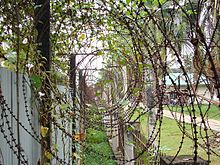
Throughout the region, there are museums commemorating specific events in the regional and local history。 This includes for example the War Remnants Museum in ホーチミン市 on the Vietnam War, the Tuol Sleng Genocide Museum in Phnom Penh on the Cambodian genocide, the Aceh Tsunami Museum in バンダアチェ, Indonesia on the 2004 Boxing Day tsunami that killed about 250,000 people (more than half of them in Aceh), and the Resistance Museum in ディリ on the East Timorese struggle for independence.
Among the key places to go for modern art collections are Singapore (for example the National Gallery in the Riverside district) and the town of ウブド in Bali, which boasts dozens of art galleries and museums.
Botanical gardens are plentiful throughout the region. The most extensive and well-known among them include the Botanic Gardens in Singapore's 北と西 district, the Nong Nooch Tropical Garden near パタヤ in Thailand, and the Botanical Gardens of ボゴール インドネシアで。
Archaeological sites and precolonial heritage

Southeast Asia has a huge number of archaeological sites, ranging from prehistoric remains of early humans that may be more than 1 million years old to great Hindu and Buddhist temples from the 8th to 14th centuries. Historic sights from the precolonial era are covered in this section, while colonial heritage is covered in the next section.
三 prehistoric archaeological sites in Southeast Asia are on the World Heritage List. The so-called Sangiran Early Man Site can be found near ソロ in Indonesia, with fossils of early humans (related to the 'Java Man') that are estimated to be between 700,000 and 1,000,000 years old, possibly older. In Malaysia's ペラ state, the Lenggong Valley contains four archaeological sites with tools, weapons jewellery and other equipment from various ages, and the 'Perak Man' skeleton. The archaelogical site of Ban Chiang near ウドンタニ in Thailand includes pottery that was painted red and dates to 2,000-4,000 years ago.

今日では、 ヒンドゥー教 in Southeast Asia is mostly limited to the Indonesian island of バリ and the Indian communities of マレーシア, ミャンマー そして シンガポール、ながら 仏教 is concentrated in インドシナ, タイ そして ミャンマー and among overseas Chinese communities throughout the region. However, from about the 4th to the 15th centuries, Hinduism, Buddhism and a combined observance of both were adhered to by the vast majority of Southeast Asians, and this led to the construction of many Hindu and Buddhist temples across the region. Two world-famous Buddhist temples, and major tourist attractions, are ボロブドゥール in Indonesia (8th-9th centuries) and アンコールワット in Cambodia (12th century, and partly a Hindu temple complex). Major Hindu temples include 私の息子 (4th-14th centuries) in Vietnam, プランバナン (9th century; near the Borobudur temple) in Indonesia, プレアヴィヒア (11th-12th centuries) in Cambodia, and ワット・フー (11th-13th century) in Laos. All of these temples are World Heritage Sites.
Other key historic sights in Southeast Asia from precolonial times include the Sukhothai Historical Park in Thailand that used to be the capital of the Sukhotai Kingdom (13th-15th centuries), the Pyu Ancient Cities in ミャンマー中部 (2nd century BCE to 11th century), the ancient town and trading port of ホイアン in Vietnam (15th to 19th century), and the ancient capital of アユタヤ in Central Thailand (14th century). Myanmar also boasts the archaeological sities of バガン そして ムラウク・ユー, which were once the great capitals of ancient kingdoms of the Bamar and Rakhine ethnicities respectively, and each home to literally thousands of ancient temples. Near the city of マンダレー です Inwa, which served as one of the last capitals of the Burmese kingdom before it was conquered by the British. Two famous old citadels can be found in Vietnam: the 11th-century ハノイ Citadel and the 14th-century Citadel of the Ho Dynasty in the セントラルコースト 領域。 The Central Coast also boasts the city of 色相, the last capital of the Nguyen Dynasty, which continued to rule in name under French suzerainty until 1945.
植民地時代の遺産
_-_Francis_Xavier_Statue.jpg/220px-1521_St_Paul's_Church_(Ruins)_-_Francis_Xavier_Statue.jpg)
With the exception of Thailand, all Southeast Asian countries were under European colonial rule for varying lengths of time between the 16th and 20th centuries. As a result, there is a considerable colonial heritage in the region, including fortifications, infrastructure and buildings. Despite remaining independent, even Thailand did not escape European influence, and it too boasts several impressive European-style buildings.
One of the key historic towns of Southeast Asia is マラッカ, the capital of the Malacca Sultanate that was subsequently under Portuguese, Dutch and British rule. Some of the highlights of Malacca include the Portuguese fortress A Famosa (1511) and St. Paul's Church (1521), and the Dutch Stadthuys (city hall, 1650). British colonial architecture can be found among others in Central Kuala Lumpur (such as the 官公庁 built at the end of the 19th century) and in Singapore's リバーサイド 範囲。 Arguably the greatest concentration of British colonial architecture can be found in ジョージタウン そして ヤンゴン.
From 1619 to Indonesian independence, the capital of the オランダ領東インド だった バタビア (現代 ジャカルタ)。 A huge number of colonial remnants can therefore be found in the city, ranging from the Batavia City Hall (built 1707-1710, now the Jakarta History Museum) in 西ジャカルタ to the Neo-Gothic Jakarta Cathedral (built 1891-1901) in 中央ジャカルタ。 Also throughout the rest of the Indonesian archipelago, virtually every city and town has sights from the colonial time, such as the 17th-century Fort Rotterdam に マカッサル, the 18th-century Fort Vredeburg に Yogyakarta, and many early 20th-century アールデコ masterpieces in Bandung。 In the early 19th century, the 大横断道路 was constructed across Java, enabling quick trade and development of the entire island.
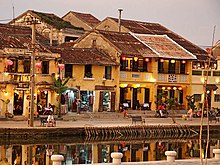
A large number of Catholic churches were built in the スペイン語フィリピン, with four baroque churches listed on the UNESCO World Heritage List (among others the San Agustín Church in Manila's historic centre and the Miagao church in イロイロ)。の歴史的な町 ビガン is a Hispanic town well known for its cobblestone streets and unique mixed European-Oriental architecture. After the Philippines came under American rule, many Art Deco civil government buildings were constructed.
French colonial architecture can be found throughout former フランス領インドシナ。 The former capital of Laos, Luang Prabang, is on the World Heritage List for its well-preserved blend of colonial and pre-colonial architecture. Similarly, the old towns of ハノイ そして ホイアン in Vietnam have lots of buildings in French Colonial style, while its largest city, ホーチミン市, is also home to several impressive French colonial buildings such as the Saigon Central Post Office, City Hall and the Saigon Opera House.
その他の観光スポット
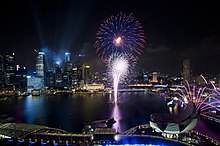
There are dozens of cities with a population of more than a million in Southeast Asia, and many of these have impressive cityscapes。 The main modern city of the region is Singapore, whose マリーナベイ area has a particularly recognizable skyline. The other main cities also have a large number of skyscrapers and office towers, notably ジャカルタ, クアラルンプール, マニラ, バンコク、および ホーチミン市。 The administrative capital of Malaysia, プトラジャヤ, is a planned city with a surreal mix of modernity and tradition.
ブルネイ is the only country of Southeast Asia that is a sultanate, and the residential palace of the sultan, Istana Nurul Iman, is considered the largest palace in the world. However, it is usually not accessible to the public. Throughout history, numerous sultanates have reigned over several parts of Southeast Asia, with some of the most powerful ones being the Mataram Sultanate (of which the remaining sultanates of ソロ そして Yogyakarta are successors) and the マラッカ sultanate. Sultan palaces and related museums can be found throughout the region, especially in Malaysia and Indonesia.

With Malaysia, Brunei, and Indonesia being majority Muslim countries, there are many mosques 地域の。 Prominent mosques include the イスティクラルモスク に 中央ジャカルタ (the largest mosque of the region, with a capacity of 200,000), the ブルーモスク に シャーアラム、 そしてその Omar Ali Saifuddien Mosque に バンダルスリブガワン.
War-related sights (apart from the museums mentioned above) can be found in most of the countries in the region. In Cambodia, the Killing Fields of Choeung Ek near Phnom Penh offer a reminder of the Cambodian Genocide. In Vietnam, there are many sights related to the Vietnam War, such as the Demilitarized Zone around the former border between North and South Vietnam, and the Cu Chi tunnel system. In Indonesia, there are numerous sights related to the War of Independence, such as the Monas national monument in 中央ジャカルタ.
Visitors with an interest in military history can find many remnants from the 太平洋戦争 そしてその Indochina Wars.
旅程
行う
ウォータースポーツ
- スキューバダイビング is a major draw for visitors to Southeast Asia, with インドネシア, マレーシア、 フィリピン そして タイ all boasting world-class diving locations.
- Surfing is also an increasing popular sport especially in インドネシア (と ニアス そして バリ the top draws) and the フィリピン.
- Sailing is popular, especially in タイ南部
- Try wake boarding at Southeast Asia's largest wake boarding centre in カマリネススル, フィリピン.
- Explore one of the world's longest underground rivers in the Puerto Princesa Subterranean River National Park located in パラワン, フィリピン.
マッサージ
Southeast Asia, in particular インドネシア そして タイ, is well-known throughout the world for its traditional massages. While the conditions of massage parlours vary, those in major hotels in touristy areas are usually clean, though you would generally pay a premium for them. Nevertheless, prices remain much lower than in most Western countries, with 1-hour massages starting from around USD5–20.
スポーツ
- 東南アジア競技大会 - Known in short as the SEA Games, it is held every two years among the 11 countries of Southeast Asia in odd-numbered years. It is structured similarly to the Olympics, albeit on a much smaller scale, and also features several sports that are only popular within Southeast Asia such as sepak takraw (essentially volleyball played with the feet instead of hands, known for its spectacular overhead kicks), and silat (a Malay martial art). The last edition was held in the Philippines in 2019, and the next edition will be held in Hanoi, Vietnam in 2022.
購入
Every Southeast Asian country has its own currency except for East Timor. The US dollar is the official currency of 東ティモール, the unofficial currency of カンボジア そして ラオス, and (for larger payments) is widely accepted in some Southeast Asian cities. Euros are also widely accepted in the major cities, although rates are rarely as good as for dollars. Thai baht are widely accepted in カンボジア, ラオス そして ミャンマー。なので シンガポール is considered to be the main financial centre of Southeast Asia, Singapore dollars would generally be accepted in major tourist areas if you're in a pinch (and are legal tender in Brunei), though the conversion rate might not be very favourable. Exchange rates for Southeast Asian currencies tend to be very poor outside the region, so it's best to exchange (or use the ATM) only after arrival. Alternatively, Singapore and 香港 have many money changers who offer competitive rates for Southeast Asian currencies, so you might plan to spend a night or two in transit for you to get your money changed.
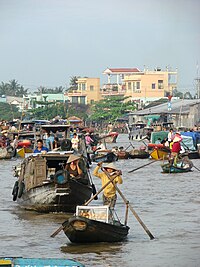
費用
Southeast Asia is 安いです, so much so that it is among the cheapest travel destinations on the planet。 USD20 is a perfectly serviceable daily backpacker budget in most countries in the region, while the savvy traveller can eat well, drink a lot and stay in luxury hotels for USD100 per day.
Some exceptions do stand out. The rich city-states of シンガポール そして ブルネイ are about twice as expensive as their neighbours, while at the other end of the spectrum, the difficulty of getting into and around underdeveloped places like ミャンマー, 東ティモール and the backwoods of インドネシア drives up prices there too.に シンガポール in particular, the sheer scarcity of land drives accommodation rates up and you would be looking at more than USD100 per night for a four-star hotel.
ショッピング
Southeast Asia is a shopping haven, with both high end branded goods and dirt cheap street goods. The most popular city for shopping in Southeast Asia is バンコク、しかし ジャカルタ, クアラルンプール, マニラ, ホーチミン市 そして シンガポール all have extensive arrays of exclusive shopping malls stocked with haute couture labels. On the other end of the spectrum, street markets remain a part of daily life (except in Singapore) and are the place to go for dirt cheap or counterfeit items. Some towns like チェンマイ タイと ウブド in Bali, Indonesia are well known for enormous markets selling traditional artworks, and it's often possible to buy directly from local artists or have dresses, jewellery, furniture, etc., made to order.
Clothes and accessories of international brands are usually just as expensive as in developed countries, or even more expensive. Branded products that seem considerably cheaper (such as Polo Ralph Lauren shirts in インドネシア) are typically 偽造, even when they are not sold in the streets but in a legit-looking shop or air-conditioned shopping mall. If you need a good compromise between low price of street sold items and the quality of branded products, look for stores of domestic brands such as マレーシア's F.O.S or フィリピン' Bench.
For slightly higher-end gifts, Malaysia's Royal Selangor is the world's foremost manufacturer of pewter products.
交渉
Bargain in public markets and flea markets where prices aren't fixed. Southeast Asians actually will give you a bargain if you make them laugh and smile while naming your price; if they don't, try saying bye bye and smile and maybe the vendor might change his mind and give you a discount. When bargaining for simple things like watches, sunglasses, and shoes remember that these are often marked up hugely and, given some bargaining skill, can often be brought down to something like 20% of the asking price. If you can't seem to get them down to a reasonable price, then you're doing it wrong.見る 交渉 for more tips.
As a rule of thumb, if a price is not explicitly posted, you need to haggle for it. However even posted prices can often be haggled down as well.
食べる


Southeast Asian cuisine reflects the countries' diverse history and culture. It can be roughly split into Mainland Southeast Asia (Thailand, Vietnam, Cambodia, ラオス そして ミャンマー) and Maritime Southeast Asia (Malaysia, Singapore, ブルネイ, Indonesia, 東ティモール), and even then still differs considerably from area to area. 中国語 そして インド人 influences have been fused with local ingredients, techniques and tastes in many parts of Southeast Asia.ザ・ フィリピン' food culture is the most varied due to their additional influences from スペイン そして アメリカ.
Street vendors or hawkers are a culinary cornerstone of the region, offering wonderful food at a very inexpensive cost; if you're scrupulous about hygiene, go for the char-grilled, deep-fried or boiled-silly options. タイ語 そして ベトナム語 dishes like the ubiquitous パッタイ and beef フォー have been widely exported around the world after the Vietnam War, followed closely by Malaysian restaurants, but a common refrain is that they simply cannot compare with a fresh bowl served by the roadside. シンガポール probably serves as the easiest introduction to street food, though バンコク そして ペナン have the better hawkers, with ホーチミン市 not far behind.
ご飯 is the main Southeast Asian staple, with 麺 of all sorts an important second option. It's common to take a rich soupy bowl of noodles or some congee (rice porridge) for breakfast. Roti canai に マレーシア、 として知られている ロティプラタ に シンガポール, is based on the Indian paratha (flatbread) while Vietnam, Cambodia and Laos have a fondness for French baguettes courtesy of their colonial history, epitomised by バインミー (Vietnamese sandwich).
Love of the spicy chilli is also shared throughout the region, and many of its most famous dishes incorporate chilli whether as a core ingredient or as a separate garnishing, from Thai curries and tom yum soup to the インドネシア語 牛肉 ルンダン to Malaysia's assam laksa に カンボジアの amok。 The unsuspecting diner may end up downing glass after glass of water to try and quench the burning sensation, but the local advice is to drink hot tea instead. Asking the cook to tone down the spiciness will not always work, and often your eyes will water when eating an adjusted version even as nearby locals happily slurp down their meals. Chilli is just one of the many spices used in Southeast Asian cooking, with lemongrass, tamarind and cloves popular choices to lend strong aromatic flavours to dishes.
Living next to seas and rivers, シーフード is a crowd favourite. Fish and prawns feature prominently, with fermented fish sauce and shrimp paste frequently used in everyday cooking, although shellfish such as シンガポール chilli crab is much more expensive and usually saved for special occasions or enjoyed by the well-off.
A variety of delicious フルーツ is available everywhere in all shapes and sizes, and pretty much all year round thanks to the tropical weather. Mangoes are a firm favourite among travellers. The giant spiky ドリアン, perhaps the only unifying factor between Southeast Asia's countries, is infamous for its pungent smell and has been likened to eating garlic ice cream next to an open sewer. Other distinctive Southeast Asian fruits are the purple mangosteen, the hairy rambutan and the jackfruit-like cempedak, whose exteriors hide juicy fleshy insides. Pay attention to what's in season for better taste and prices.
高級料理 is increasingly an option in the more developed countries of Southeast Asia. バンコク is generally considered to have the best fine dining scene in Southeast Asia, with シンガポール not too far behind, though there are also good options to be found elsewhere. Although fine dining is far out of the reach of the average working class Southeast Asian, with the notable exception of Singapore, prices tend to be a lot more affordable than food of a similar standard in Western countries and East Asia.
Western restaurant review websites such as Yelp are not generally reliable for South East Asian countries, as locals do not often post reviews there. Instead, there are local review websites that cover South East Asian countries, such as Eatigo, Openrice そして Zamato.
ドリンク
Rice-based alcoholic drinks — Thai whisky, チューバ, lao, トゥアク, アラック and so on — are ubiquitous and potent, if rarely tasty. In some areas, notably the Philippines, ラム is also common, made from the local sugarcane. As a rule of thumb, local booze is cheap, but most countries levy very high taxes on imported stuff.

ビール are a must try in Southeast Asia, and are often very inexpensive. Check out San Miguel (Philippines), Singha, Chang beer (Thailand), Bir Bintang, Angker Beer (Indonesia), Tiger Beer (Singapore and Malaysia), Saigon Beer, Hanoi Beer, Huda Beer, 333 Beer, Bia hơi (Vietnam), Beerlao (Laos), Angkor and Angkor Stout (Cambodia). Lager is by far the most popular style, although stout (especially Guinness) is also popular and the larger cities have plenty of microbreweries and imported brews. Beer in SE Asia is primarily consumed by locals to simply get drunk, and not for taste. As such, by Western standards, most locally produced SE Asian beers are often of comparable quality to a low-end Western beers. Don't be surprised by the local habit of adding ice to your beer: not only does it help keep it cool, but it dilutes the often high alcohol content (6% is typical) as well.
Hampered by heavy taxation and a mostly unsuitable climate, ワイン is only slowly making inroads, although you can find a few wineries in central and northern Thailand, Bali, and Vietnam. Don't buy wine in a restaurant unless you're sure it's been kept properly, since a bottle left to simmer in the tropical heat will turn to vinegar within months. The exception is the former French colonies of Laos and Cambodia which have a respectable collection of vintages available in the larger cities of ビエンチャン そして Phnom Penh.
Nearby Australia exports a good deal of wine to this region; it will be found mainly in high-end hotels or restaurants, though places catering to the budget/backpacker part of the tourist trade may have some as well. The cheap local restaurants generally will not have any.
Fruit juices and coconut water are widely available, especially among Muslims, and in other communities where alcohol is not customary.
おげんきで
Generally speaking the traveller trail in Southeast Asia is perfectly safe, but there are low-level insurgencies in the remote areas of インドネシア, ミャンマー、 フィリピン, タイ、および 東ティモール.
Violent crime is rare in Southeast Asia, but tourists have been attacked in beach resorts in a few isolated but well publicised cases.
Opportunistic theft is more common, so watch out for スリ in crowded areas and keep a close eye on your bags when travelling, particularly on overnight buses and trains.
Major dangers are very poor road safety, as well as little or no oversight of physical activities such as white water rafting and bungee jumping.
In 2004 an Indian ocean 津波 killed an estimated 230,000 people, with タイ そして インドネシアの アチェ province being severely affected. Many foreign tourists were injured or killed in this very rare yet very dangerous event.
While plenty of narcotics are produced, distributed and consumed around the region, most countries (especially Thailand, Singapore and the Philippines) have harsh penalties for possession of small amounts, and capital punishment for organized drug trafficking. Neither foreign citizenship nor bribes will save visitors from sentences.
健康を維持する
シンガポール そして タイ are two of the world's main medical tourism hubs. In Singapore, the healthcare system is of a high standard in both government and private hospitals, though prices are also the most expensive in Southeast Asia (but cheaper than most Western countries). Healthcare costs in Thailand are much cheaper than in Singapore and Western countries, making it a popular medical tourism destination for people on tight budgets. While private hospitals in general conform to international standards, and some private hospitals in Bangkok are widely regarded as among the best in the world, public hospitals often leave much to be desired.
マレーシア そして ブルネイ in general have high standards in both private and public hospitals.の中に フィリピン, while the standard of care is uniformly good at both public and private hospitals in Manila, conditions are often bad in rural areas and smaller cities.に ベトナム そして インドネシア, while public hospitals most certainly lag far behind the standards of the West, there are internationally accredited private hospitals in the major cities that are run to international standards. ミャンマー, ラオス, カンボジア そして 東ティモール generally have poor healthcare standards, so you will almost certainly want to travel to Thailand or Singapore for any major procedures; ensure that your insurance covers this.
ザ・ Joint Commission International accredits hospitals internationally based on U.S. standards; though you will be paying a premium for these hospitals, you can ensure that the care and treatment you receive will be aligned to Western standards.
尊敬
You may be asked to take off your shoes quite often, especially when entering temples or guesthouses. Wear shoes that can be slipped on and off easily, particularly if you're planning to visit a lot of temples, and make sure your socks aren't full of holes. At Buddhist temples, the areas where you have to go barefoot differ by country; in Myanmar, you will have to take your shoes off before entering the entire temple complex, while in Thailand, you are only required to take your shoes off before entering temple buildings.



.jpg/250px-DSC00096_Java_Centre_Borobudur_Stupas_and_Temple_(6219572675).jpg)


